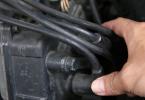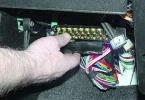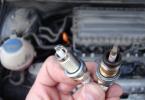During the operation of the car, its components and assemblies wear out, various adjustments change.
If the clutch pedal free travel is disrupted, the car stops moving normally, various problems arise - it becomes impossible to move, the gears change with a crunch, the car can also slip and accelerate poorly. In this article, we'll cover:
- what are the clutch malfunctions;
- how to properly adjust it;
- the main causes of breakdowns;
- how the clutch is adjusted on different car models.
The main signs of a faulty clutch drive
The clutch in the car serves to connect and disconnect the engine from the transmission, it is necessary to engage a gear, downshift or upshift. The connecting unit of the gearbox with the motor can be mechanically or hydraulically driven:
- the mechanics are controlled by a cable;
- there are master and working cylinders in the hydraulic drive.
Any actuator has the ability to adjust, and using a rod or cable, the clutch pedal (PS) can be raised or lowered.
Each clutch must have a small free play, if it is too large, then:
- PS takes at the very end of the pedal stroke, and the squeeze is not enough to normally change gears;
- the car starts to drive, even if the pedal is close to the floor;
- at a low position of the PS, the gearbox may fail.
If the PS is raised too high, and there is practically no free pedal travel, other problems arise:
- the car slips, while it accelerates poorly;
- the clutch disc (DS) starts to burn, and it does not provide a reliable connection between the internal combustion engine and the gearbox.
The main signs of a faulty mechanical drive (cable):
- squeezing is very tight, or when pressed, the pedal is not squeezed at all;
- PS is completely lowered, it lies on the floor;
- the pedal is pressed very easily.
In the cable drive, there may be the following causes of a malfunction:
- the clutch cable (TC) has soured in the cage, therefore it is difficult to "walk" in it;
- The vehicle has unraveled, and the scraps of wire do not allow the cable to move in the braid;
- the cable simply broke off.
The hydraulic drive also has its own faults, there are also signs of a faulty condition:
- the pedal fails the first time, and begins to take only from the second or third pitch;
- PS becomes "wadded", the effectiveness of the squeeze disappears;
- somewhere in the middle of the stroke, the pedal stakes.
Just like in the cable drive, the PS can be pressed very easily or not at all.
The main faults in the hydraulic drive:
- drip of the working cylinder;
- bypass valves in the master cylinder;
- all brake fluid has completely drained;
- the stem is out of alignment (the lock nut is loose, the adjustment is violated).
Commercial vehicles Gazelle are equipped with a hydraulic clutch drive.On this machine, the pedal free travel can be adjusted in only two ways:
- lengthen or shorten the stock located at the very PS in the car interior;
- put an extended or adjustable rod between the slave cylinder and the clutch fork (BC).
As the clutch disc wears out, the pedal free travel begins to increase, and in this case, adjustment is required. If this free play is too large (more than one third of the total travel),
its regulation is carried out by the rod in the cabin:
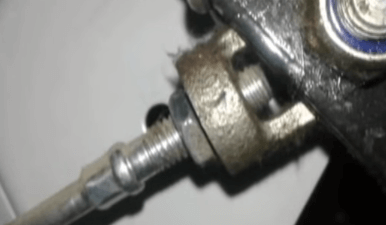
If the DS is already badly worn out, but it is necessary that it still serve, you can install an extended stem or an adjustable stem (for example, from an UAZ SUV) between the working cylinder and the fork. 
You can check the condition of the Gazelle parts by external inspection, for this you need to put the car on a pit or a lift, inspect from below:
- the clutch slave cylinder (RCS) should not have leaks;
- The sun should not have cracks or bending.
On Lada Priora and Kalina cars, a mechanical clutch drive is installed, squeezing is carried out by a cable. With the wear of the DS, the free travel of the pedal increases, and then adjustment is required.
The adjustment of the cable on Lada models is carried out under the hood; it is carried out by two nuts that are attached to the gearbox bracket. We adjust the clutch as follows:
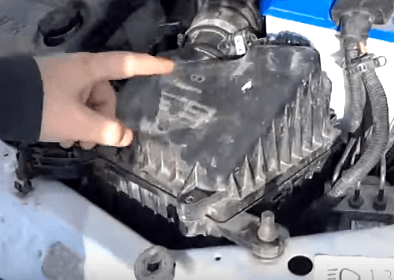
The regulation of the VAZ 2110 vehicle is carried out in the same way as on the Lada Priora or Kalina, the clutch on the "nines" and "eights" is also regulated.
On older models, such as UAZ 452 "Loaf" or UAZ 469 "Kozlik", regulation is carried out using a rod that is located between the fork and the working cylinder. A claw clutch is installed on many UMP motors of these machines, and adjustment can also be made by claw-type levers, which are located on the clutch basket (drive disc).
It should be noted that foot baskets are installed on KAMAZ, ZIL, GAZ-53/3307 trucks. 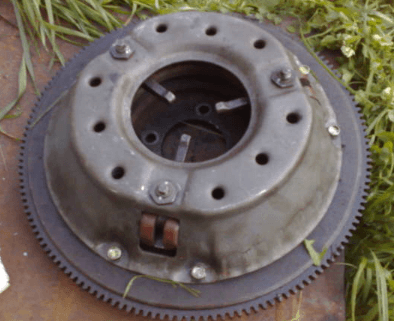
The legs can be adjusted both on the removed basket and as part of the car. On the removed parts, the operation is performed in the following order:
- install the basket with DS on the flywheel, tighten the basket with bolts;
- unlock the adjusting nuts;
- using a vernier caliper, we measure the distance from the end of the levers to the flywheel, using the adjusting nuts we set the same distance;
- according to the book instructions, the distance between the handwheel and the foot should be 51.5 mm, provided that the thickness of the disc is 9.5 mm;
- counter nut, this adjustment procedure can be considered complete.
Also, the legs can be adjusted directly on the machine without removing the clutch. We proceed as follows:
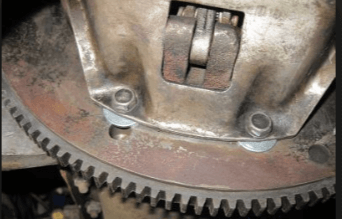
When the paws of the UAZ drive disk are worn out, some car owners, in order not to repair the basket and travel a little more, substitute washers of the same thickness under all its fastening bolts.
There is another way to adjust the legs, but it needs to be done together. The work is done as follows:
- one of the participants in the operation gets on the steering wheel and squeezes the clutch to the end;
- the second of the participants turns the flywheel, unlocks the legs, adjusts, setting the gap between the flywheel and the clutch disc of 1.5 mm, for this you need a set of probes that regulate the valves in the engine;
- the gap may differ slightly from 1.5 mm, it is important here that all legs are adjusted at the same distance;
- after completing the adjustment, we check the clutch, trying to move away. If the car starts off smoothly, counter the nuts, put the lower sump in place.
It should be noted that although the latter method is considered popular, nevertheless, such an adjustment is the most accurate.
As well as on many vehicles, the VAZ 2107 clutch pedal free play is performed from the car's interior. It is adjusted with an adjusting screw, which is located next to the PS; according to the instructions, the free travel should be from 30 to 35 mm. But not all drivers enjoy doing what the instructions say, and many customize the pedal based on their preferences.
The second adjustment is made by the rod, which is located between the RCS and the fork. On the stem, the lock nut is loosened, and the stem is set so long that it moves freely at a distance of 4-5 mm. 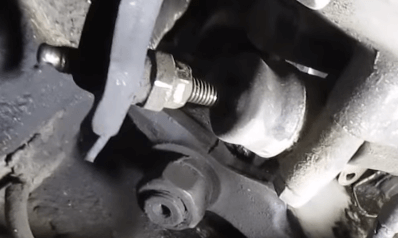
A cable drive is installed on Renault Logan cars, exactly the same cable is present on the Renault Sandero model. This drive comes with all manual transmissions, regardless of engine type. 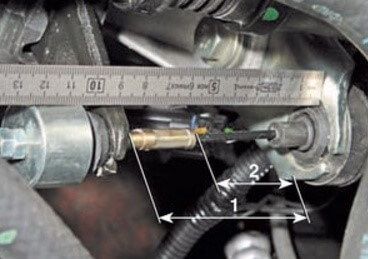
The cable is adjusted with a nut located on the cable itself, it is located next to the clutch fork. According to the factory conditions, for an unworn DS, the cable must have a length between the gearbox bracket and the fork 86 plus or minus 5 mm, which distances should be shown in the figure below.
Over time, the clutch disc wears out and becomes thinner. Because of this, the PS rises, and it is required to adjust the free play.
In order to adjust the pedal stroke, loosen the lock nut with a 10 key, hold it with a 7 hex key, turn the adjusting nut. ![]()
Having established the required position of the PS Logan, we fix the cable tension with a locknut. We check the car on the move, if the free wheeling does not suit us, we repeat the operation.
The clutch drive on Hyundai cars is hydraulic, gear shifting to the checkpoint is cabled. Hyundai Getz, Elantra, Accent, Tucson, Solaris and others are equipped with a hydraulic drive. In almost all Hyundai models, the clutch pedal is adjusted from the passenger compartment. For example, on Hyundai cars, the Accent PS is connected to the master cylinder; a rod is installed between these parts, which can be adjusted. Free stroke PS is regulated by this rod:
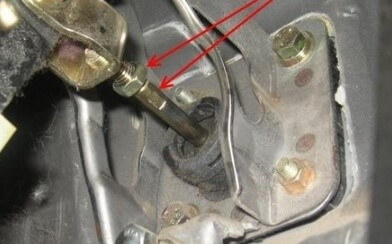
As the clutch parts (disc and basket) wear out, the amount of free play changes in the PS, and therefore it needs to be adjusted. On a Nissan car, the clutch drive can be different - mechanical and hydraulic, therefore, the PS is adjusted differently. For example, on Nissan Sunny cars in the bodies of N13 and N14, Almera, Primera, a cable is installed, Qashqai, Tiida, Almera Classic, Note, Maxima cars are equipped with a hydraulic drive.
However, the hydraulic drive can also be installed on Sunny or Primera, much depends on the type of engine, model generation. Cars with more powerful internal combustion engines (2.0 / 2.5 / 3.0 l) are usually equipped with "hydraulics" on Nissan, cars with 1.4 / 1.5 / 1.6 l engines go with a clutch cable.
On a Nissan N14 car, the cable is adjusted in the area of the clutch fork, the adjusting mechanism is located at the very end of the cable. 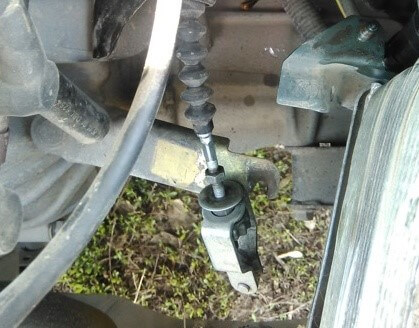
The same cable is installed on Almeria, and in order to shorten it with worn out DS linings, the owners of the cars put washers, and in this case it is no longer fixed with a locknut. 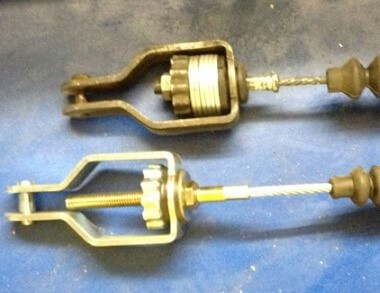
Like on Hyundai cars, the GCC on Nissan is located next to the pedal, these parts are connected to each other by a rod, on which there is an adjustment.
To adjust the free travel of the PS on the Nissan Almera N16 (Classic), you will need keys for 12 and 6. To perform the operation, loosen the lock nut by 12, then turn the stem in the desired direction with a 6 mm wrench. Having set a convenient position of the PS, we tighten the lock nut tightly - if it unwinds, the whole setting will be lost. 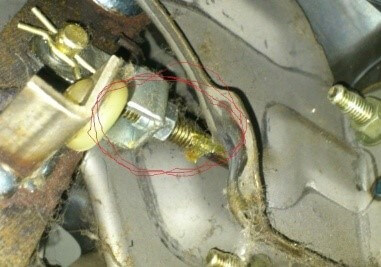
What you need to know about clutch malfunctions
- If, during the operation of the car, the PS began to gradually go up, most likely, the lining of the driven disk is worn out.
- When the clutch slips, the cabin smells of burnt linings (ferodo). It is quite simple to check the wear of the linings: we put the car on the "handbrake", start the engine, squeeze out the clutch, add gas, smoothly release the PS. If the engine hardly slows down, the disc pads are worn out. If the engine stalls, the clutch is good.
- Slip can occur not only due to worn disc friction linings, oil can get on the basket and disc. To check the guess, you need to install the car on a lift or pit, make an external inspection of the engine and gearbox from below. Oil enters the clutch through the oil seal of the input shaft of the gearbox, through the rear oil seal of the internal combustion engine.
- If the PS got a stake, then it could be: the fork sour, the piston is jammed in the working cylinder, the fork flew off the release bearing hub (on ZMZ-402, UMZ engines of various models).
- If the PS has become "wadded", and in order to normally change the gear, it is necessary to depress the clutch pedal twice, which means that they began to bypass the valves of the master cylinder. In this case, the GCC needs to be repaired or replaced.
